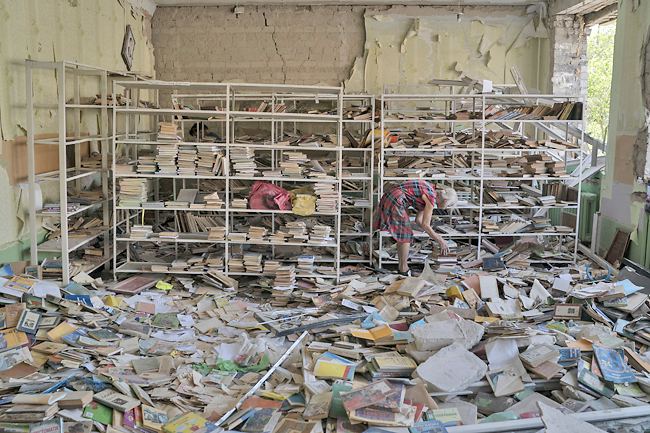MYKHAILO-KOTSYUBYNSKE, UKRAINE (AP) – The first day of school in Ukraine won’t include children sharing memories of fun vacations with their families. Their stories are of surviving war. For many, their last day of school was the day before the February 24 Russian invasion of their country.
At least 379 children have been killed since the war began, while the whereabouts of 223 others are unknown, according to Ukraine’s General Prosecutors office. Another 7,013 children were among Ukrainians forcibly transferred to Russia from Russian-occupied areas.
Some children were forced to flee their hometowns to avoid bombardment, some spent weeks in basements. And while those in so-called “safe” regions sometimes managed to study online, classes were frequently interrupted by air raid sirens.
Six months of war damaged 2,400 schools across the country, including 269 that were destroyed, according to Ukrainian officials.
Civilian areas and schools continue to be hit, and children keep being killed. But after the first months of shock, 51 per cent of schools in Ukraine, despite the risk, are re-opening to in-person education, with an option to study online if the parents prefer.
“Education is critical to a return to normality. That’s fundamental,” said UNICEF spokesperson James Elder.
But the safety of children remains the priority. Schools that don’t have quick access to shelters or are located close to the borders with Belarus and Russia, or near active military zones will only have online study.
That’s the case for the seventh graders in Mykhailo-Kotsyubynske, just 35 kilometres from the Belarus border, who gathered at their badly damaged school on Tuesday to pick up textbooks for studying online. While waiting, they played a version of ‘Truth or Lie’, where players tried to guess whether their opponent’s assertion about the number of missiles they saw from their window was true or false.



“We haven’t seen each other for such a long time. You all have grown so much,” said their teacher, Olena Serdiuk, standing in a corner of the classroom, where windows were covered with thick black polythene instead of glass.
Oleksii Lytvyn, 13, remembers very well the day Russian missiles hit the school twice. It was March 4, and he was in the school’s bomb shelter with his family and dozens of other people.
Just minutes before the blast, he had been playing with a friend.
After the loud explosion, the walls began shaking and he couldn’t see anything but a huge cloud of dust. One person was killed, a woman who worked at the school.
“We were sleeping in the corridor, and there was a corpse of a dead person behind the wall,” Oleksii recalled. His family stayed one more night before fleeing town, though they have since returned for the start of the school year.
Oleksii’s classmates shared similar stories about that day and the month-long Russian occupation of Mykhailo-Kotsyubynske that followed.
“When I’m at school, I think about the person who died in the debris. I feel deeply sorry for her,” 12-year-old Mykola Kravchenko said.
Their school, the biggest in the area with 407 students from Mykhailo-Kotsyubynske and nearby villages, is still badly damaged.
Debris fills the second floor, and the roof and heating system still need to be repaired – money the school doesn’t have.
Even though they will be studying online, the students had to undergo security training on Tuesday.
Serdiuk told the class to follow her to the same bomb shelter where many survived the blast in March. In the dimly lit shelter were water supplies and lines of long benches with labelled seats for each classroom.
When the children took the seats assigned to their class, Serdiuk told them they had to go there whenever they heard a short bell ring.
She said many parents tell her their children are begging them to return to school, but for now that isn’t allowed because of the danger of being so close to the Belarus border.
“Ukrainian children are acutely aware that the world is unstable and it could be a terrible place. That brings… a loss of a basic sense of safety,” said Elder, adding that the uncertainty can impact their learning and emotional and social development.
Schools in the Kyiv, Lviv, and Chernivtsi regions are among those welcoming students back to classrooms. However, it’s up to parents whether they send their children to school or opt for online education.
The Kyiv and Lviv regions will host more than 7,300 displaced students who were forced to flee their hometowns and escape life under constant fire, officials said.
In Kramatorsk in the Donetsk region, there is no hope for schools to open their doors to students. The city has been under constant shelling since the beginning of the war.
In one city school, the first-grade classroom was all ready: tables, chairs, a clean blackboard, the alphabet and numbers hanging on the wall, and Ukrainian flags ready to be distributed to the kids.
The only thing missing was the students. Seated in the middle of the empty room was Oleksandr Novikov, 55, the school’s director for 12 years and a teacher for more than 20.
“It is very depressing, it is very unpleasant to feel that you come to an empty school,” he said.
“There will be no children laughing at school, no one will be running here” when the school year begins.
While Ukraine tries to defend itself from the Russian invasion, Novikov dreams of better times.
“I would like a real first bell, a real meeting with children and teachers, a real lesson, when eyes look at you with inspiration, trust and a desire to hear something new, to learn something new.”
“This is what I would like to see,” he said.





